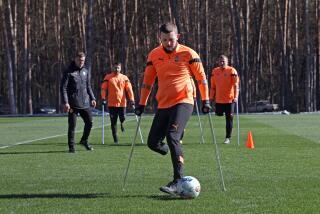Disfigured Iraqis Are No Longer Scarred for Life
BAGHDAD — Rolling on a gurney toward the dank operating room of Al Kindi Hospital recently, Khalid Abid Nimer flashed back to a decade earlier, when he had made a similar trip in the same hospital for a far different operation.
Back then, Nimer’s arms were bound and his eyes were blindfolded to prevent him from seeing the reluctant surgeon who was ordered to carry out one of Saddam Hussein’s sadistic punishments: cutting off the right ears of Iraqi men deemed to be traitors.
Nimer awoke alone in a recovery room that day, a solitary start to a life of shame and isolation. An estimated 3,600 Iraqis suffered the same fate, according to the newly formed National Iraqi Assn. for the Defense of Human Rights. Now hundreds of them are rushing to get plastic surgery to repair the physical wounds -- and the psychological ones.
One or two such operations, in which surgeons build a new ear from cartilage taken from the rib cage, are performed each week in Baghdad, doctors say.
Nimer’s was one of the first. After his operation this time, the 33-year-old awoke to see his parents and two brothers standing around his hospital bed. The entire family broke down in tears.
Weak and groggy, Nimer struggled to lift his bandaged head, as if to whisper something to the surgeon. When the doctor leaned in, Nimer kissed his cheek.
“I’m reborn,” he said.
Men such as Nimer are a largely forgotten fraternity of mostly poor, uneducated young Iraqis who, for different reasons, ran away from military service in Hussein’s army between 1994 and 2001, the year such punishments ended.
The official Baath Party line was that such men should be shunned and ridiculed as deserters. Today, most of the victims are still unemployed because of old laws that banned businesses from giving them jobs. Few married, because families and tribes forbade their daughters and sisters from having any contact with them.
“These operations will help the men retrieve some of their dignity, to return to more normal lives,” said Mohammed Hussein, co-founder of the Iraqi human rights group, which was formed after the fall of the regime and has helped fund the surgeries.
In post-Hussein Iraq, there’s no shortage of human rights abuses to heal: massacres, torture, false imprisonment. Victims of the ear-cutting campaign have received less attention, even as their disfigurement continues to cause stigmatization.
“It made me ugly,” said Khalid Ali Showkan, 33, whose ear was cut off in 1995, leaving a mangled scar and misshapen hole. “When I see myself in the mirror, I can’t stand what I see.”
The severity of the disfigurement varies widely from person to person.
“It depended upon how bloody the doctor was,” Showkan said with disgust. His doctor left nothing of his ear, while others cut only a small V-shaped chunk from the edge.
Showkan was 24 when he abandoned his army unit after serving nearly five years of mandatory, low-paying service. Like others, he said he quit to find a job to help support his widowed mother and younger siblings.
Today, he doesn’t go anywhere without wearing a red-and-white scarf wrapped tightly around his head.
“Since 1995, winter or summer, day or night, I live with this scarf,” he said. “When I take it off, I feel naked.”
Even at home, he is rarely without it in front of his wife or 5-year-old daughter. When he is, he tries to keep to his daughter’s right or casually cover the right side of his head with his hand, to prevent the little girl from staring.
He considers himself lucky to have found a wife. Her parents had objected to the marriage. “But she said, ‘Because Saddam Hussein is to blame for this, I accept,’ ” Showkan recalled.
As Showkan shared his story recently with another victim he met at the human rights group’s Baghdad office, the man looked at him in amazement and shook his head. “That is not just a woman,” the unmarried man said. “That’s a gem.”
Victims of Hussein’s ear-cutting campaign suffer from a variety of psychological problems, doctors say, ranging from depression and self-loathing to violent behavior.
“They isolate themselves and become antisocial, resorting to violence or abusive behavior directed against themselves or their family,” Said Sami Hashemi, a psychiatrist at Yarmuk Hospital in Baghdad, said. “They have become socially handicapped.” Thoughts of suicide are not uncommon, he said.
“Sometimes I would have preferred to die,” said Saad Mohammed Allwan, 34, whose ear was cut in 1994 after he refused to participate in the army’s campaigns against the ethnic Kurds in the north.
Upon arriving home after deserting, he found a job in a bakery. But his stepmother turned him in to authorities.
After the mutilation and prison time, he learned that his father had died and that his stepmother had sold the house and moved away. He spent the next 10 years drifting, homeless and unemployed, avoiding contact with other people. “I see it in every eye I meet,” he said.
This year, Allwan saw a poster at a bus stop offering plastic surgery to victims of ear mutilation. Now he works for the rights group, helping coordinate surgeries and offering support to others.
“We tell people, it’s not them who are abnormal, it’s Saddam Hussein and his regime,” said Yahia Attabi, a human rights attorney and co-founder of the group.
Many are still haunted by their first operation -- not because it was painful or violent, but because it was carried out in such a cold, orderly manner.
“I will never forget those moments,” Showkan said. Like most others, he was bound and blindfolded. When prison guards brought him to the hospital, he grew more anxious. He had heard rumors about the ear mutilations but did not believe them. The next thing he felt was a needle in his arm, and then he fell asleep.
He awoke in a prison cell. “I felt something itching my ear,” he said. “When I went to scratch it, I felt the bandage. That’s when I knew the rumor was true.” There were no mirrors, but his cellmate had suffered the same fate. Each man could only examine the other and imagine what had happened to him.
Sometimes the punishers tried to be humane. As Raad Jasim Haamza lay on the operating table 10 years ago, he said, the surgeon whispered to him: “You’re going to thank me every time you look in the mirror. But keep the bandage on so the guards don’t see. If they see, they will send you back for a bigger cut.”
The most severe reconstructive cases will require four or five operations over a year. Such operations were possible in the past, but it was illegal for doctors to perform them on men whose ears had been cut by the government.
At Al Kindi Hospital, many of the surgeons who are repairing the ears today remember working at the facility during the butchering.
“We were just students then,” said Hamid Bressen, who performed the reconstructive surgery on Nimer. “Thankfully, we were not asked to perform these operations.”
But they recall the sense of dread that they might one day be put in such a position. Doctors who refused were fired, imprisoned and threatened with execution.
“As a doctor, it was so difficult,” said Ziad Ansary. “You couldn’t refuse.”
A month after his reconstructive surgery, Nimer was back home with his family, working at construction sites temporarily while he looked for a permanent job.
His parents have already noticed a change. He leaves the house more frequently to see friends. He laughs again and enjoys playing with his nieces. They hope that their son will even marry and start a family.
“It feels so good to be able to walk around on the street again and not be embarrassed or feel like people are looking at you,” Nimer said. “I just want to be normal again.”
*
Special correspondent Said Rifai contributed to this report.
More to Read
Sign up for Essential California
The most important California stories and recommendations in your inbox every morning.
You may occasionally receive promotional content from the Los Angeles Times.










